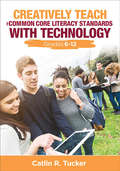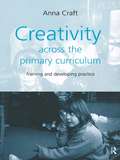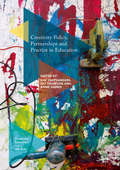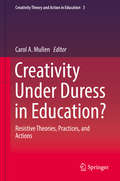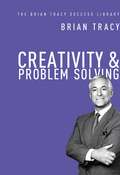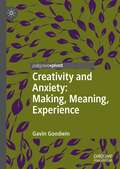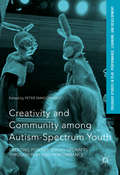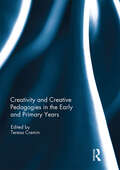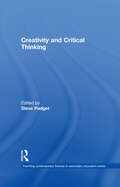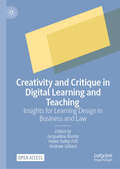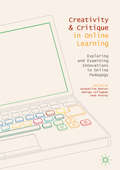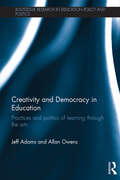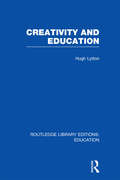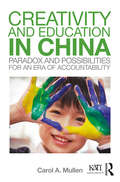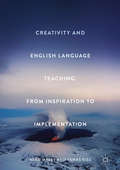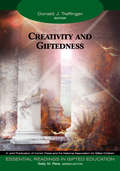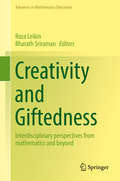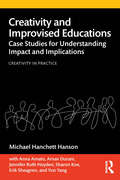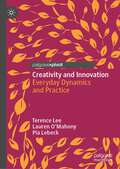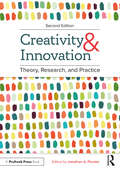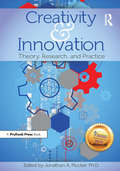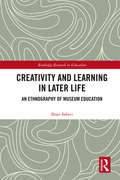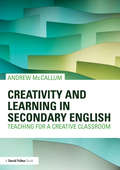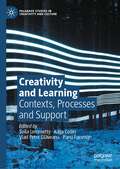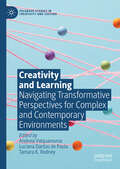- Table View
- List View
Creatively Teach the Common Core Literacy Standards With Technology: Grades 6-12 (Corwin Teaching Essentials)
by Catlin R. TuckerLet technology pave the way to Common Core success. Your transition to the Common Core just got easier! When you start getting creative with technology, you’ll turn your classroom into a student-centered learning environment that fosters collaboration, individualizes instruction, and cultivates essential technological literacy. This book is your road map to student success—while meeting the Common Core ELA and literacy standards. Features include: Specific recommendations for free apps and tech tools that support the Common Core Step-by-step guidelines to breaking down a Common Core standard for your grade and subject Teacher-tested, lesson ideas and teaching strategies Replicable resources, including prewriting activities and writing templates Real-life examples You don’t need to be in a 1:1 school to do amazing things with technology. With just a few devices, you can engage a whole class! Delve into the Common Core ELA standards by having students experiment creatively with the tech tools at hand for a more meaningful and resonant learning experience. "The book contains a tremendous collection of actionable ideas that can be seamlessly implemented to make a difference in all aspects of the classroom. A must-own guide that will surely be a teacher′s go-to resource to help bring the standards to life." Adam Bellow, Founder of eduTecher / eduClipper Plainview, New York "Catlin Tucker provides great ideas for student use of technology tools that cross the curriculum areas and allow the students to showcase their mastery of content. Students will love how the traditional classroom assessments are transformed!" Kathy Schrock, Educational Technologist, Adjunct Instructor Wilkes University, PA
Creativity Across the Primary Curriculum: Framing and Developing Practice
by Anna CraftThis book takes an inspirational look at how to foster children's creativity as well as following the guidelines in the National Curriculum. The book: explores the nature of the creative mind investigates the role of play and the concept of creativity examines appropriate continuing professional development for teachers looks at the personal and professional identities of teachers considers ways of analysing and describing creative practice. This text looks at the bigger picture in education, asking what sort of systems need to be designed to develop children's learning in the 21st century. It will be a resource to teachers, head teachers and advisory staff committed to asking questions, encouraging play and not allowing problems or circumstances to block action.
Creativity Policy, Partnerships and Practice in Education (Creativity, Education and the Arts)
by Pat Thomson Anne Harris Kim SnepvangersThis book examines the gaps in creativity education across the education lifespan and the resulting implications for creative education and economic policy. Building on cutting-edge international research, the editors and contributors explore innovations in interdisciplinary creativities, including STEM agendas and definitions, science and creativity and organisational creativity amongst other subjects. Central to the volume is the idea that good creative educational practice and policy advancement needs to reimagine individual contribution and possibilities, whilst resisting standardization: it is inherently risky, not risk-averse. Prioritising creative partnerships, zones of contact, practice encounters and creative ecologies signal new modes of participatory engagement. Unfortunately, while primary schools continue to construct environments conducive to this kind of ‘slow education’, secondary schools and education policy persistently do not. This book argues, from diverse viewpoints and methodological perspectives, that 21st-century creativity education must find a way to advance in a more integrated and less siloed manner in order to respond to pedagogical innovation, economic imperatives and creative possibilities, and adequately prepare students for creative practice, workplaces and publics. This innovative volume will appeal to students and scholars of creative practice as well as policy makers and practitioners.
Creativity Under Duress in Education?: Resistive Theories, Practices, and Actions (Creativity Theory and Action in Education #3)
by Carol A. MullenCreativity Under Duress in Education? introduces a new framework—creativity under duress in education. Leading creativity researchers and educational scholars discuss creative theory and practice from an educational lens that is provocative. Across international contexts, this book combines insights from creativity and educational research; rich illustrations from classrooms, schools, and other professional settings, and practical ideas and strategies for how anyone invested in education can support creative teaching and learning. Readers will encounter diverse perspectives from an international cast of authors exploring cutting-edge ideas for creativity and innovation as a foremost priority for economies in the new millennium. At the same time, they consider forces of authority, control, and constraint that impact creative education and innovation within educational systems, extending to the professions. Educators and those interested in the future of education are vitally important to this conversation around research-based and practical analyses of creativity in and beyond the classroom. Addressed are these major issues: (1) creativity frameworks of theory and action in education, (2) research investigations into creativity and education, and (3) applications of creativity theory in real-world practice.Dynamic, this book presents a bridge between draconian contexts of assessment and explosive creativity in diverse places. A key contribution of the volume is its validation and promotion of creativity and innovation for students, teachers, professors, leaders, employers, policymakers, and others seeking ways to profoundly improve learning and transform education. In tackling the seemingly irreconcilable issues of creativity and accountability in K–12 institutions, higher education, and policy circles, worldwide, this work offers a message that is both cautionary and inspiring. Book editor Carol A. Mullen, PhD, is Professor of Educational Leadership at Virginia Tech, Virginia, USA. A twice-awarded Fulbright Scholar to China (2015) and Canada (2017), she was honored with the 2016 Jay D. Scribner Mentoring Award from the University Council for Educational Administration. She is author of Creativity and Education in China (2017) and co-editor of Education policy perils (2016).
Creativity and Problem Solving: The Brian Tracy Success Library (Brian Tracy Success Library)
by Brian TracyThe hallmark of an exceptional career is the ability to devise innovative solutions for work challenges. Therefore, creative thinking skills are vital for your professional advancement.Recent research has revealed a direct causality between ideas and profitability, which means that in today&’s competitive and technology-rich work environment, the most crucial element separating an extraordinary career from an ordinary one is creative thinking skills.As one of the world's premiere success experts, Brian Tracy knows anyone can become more creative by practicing with a few helpful tools. This concise, easy-to-read book guides you to immediately begin generating a stream of productive ideas.In Creativity & Problem Solving, Tracy reveals 21 proven techniques that will help you:Stimulate the three primary triggers to creativityInspire a creative mindset in staff through recognition, rewards, and environmentUse methods to solve problems, improve systems, devise new products, and come up with fresh, exciting marketing anglesAsk focused questions to generate elegant solutionsUnderstand the difference between mechanical and adaptive thinkingRigorously evaluate new ideas without shutting down the creative impulseContaining mind-stimulating exercises and down-to-earth strategies, Creativity & Problem Solving will help you tap into the root source of their own intuitive genius--and gain the winning edge they&’ve been missing all this time.
Creativity and Anxiety: Making, Meaning, Experience (Palgrave Studies in Creativity and Culture)
by Gavin GoodwinAnxiety is perhaps the defining psychological malady of our age, whereas creativity is seen as an almost unassailable good, its importance heralded and promoted in a range of disciplines and domains. A number of diverse thinkers and researchers have tried to unpick the relationship between anxiety and creativity, and this short book explores and connects some of their ideas and findings. Drawing on psychoanalysis and neuroscience, existential psychology and mindfulness, literary studies and philosophy, this book places a range of different disciplines in dialogue. It explores how creativity and anxiety might impact one another, and argues for the importance of establishing a diverse and inclusive cultural space which everyone can draw from and contribute to.
Creativity and Community among Autism-Spectrum Youth: Creating Positive Social Updrafts through Play and Performance (Palgrave Studies In Play, Performance, Learning, and Development)
by Peter SmagorinskyThis edited volume explores the roles of socially-channeled play and performance in the developmental trajectories of young people who fall on the autism spectrum. The contributors offer possibilities for channels of activity through which youth on the autism spectrum may find acceptance, affirmation, and kinship with others. "Positive social updraft" characterizes the social channels through which people of difference might be swept up into broader cultural currents such that they feel valued, appreciated, and empowered. A social updraft provides cultural meditational means that include people in a current headed "upward," allowing people of atypical makeups to become fully involved in significant cultural activity that brings them a feeling of social belonging.
Creativity and Creative Pedagogies in the Early and Primary Years
by Teresa CreminWhilst recognition of the role and nature of creativity and interest in creative pedagogical practice has grown, tensions persist at several levels, particularly in accountability cultures, where international comparisons of literacy, numeracy and science frame, shape and often limit policy, practice and curricula. Responding to this context, the book draws together the work of a number of eminent scholars of creativity and creative pedagogies. It offers diverse perspectives from Colombia, Denmark, England, France, Poland, Hong Kong, and the USA and highlights differences as well as similarities across cultural contexts. Individually and collectively, the authors reveal both the complexities and the possibilities of creative pedagogies. While some focus more upon conceptual challenges, others examine classroom practice, both that of teachers and visiting artists, and identify difficulties as well as potential possibilities. In offering hope as well as challenge, creative approaches to learning are of interest to all educators. This book was originally published as a special issue of Education 3-13: International Journal of Primary, Elementary and Early Years Education.
Creativity and Critical Thinking
by Steve PadgetWhat do we mean by creativity? What is the link between creativity and critical thinking? How can creativity and critical thinking be incorporated into classroom practice and what are the benefits for students? Creativity and critical thinking are central to effective teaching and learning and have a significant impact on students’ attainment, engagement, attendance and behaviour. This book draws on recent research and policy to provide teachers with a clear framework for understanding creativity and critical thinking and practically demonstrates how they can be incorporated into classroom practice. Bringing together an expert team of contributors with a wide-range of experience of bringing creative approaches into the classroom the book includes: an analysis of the issues associated with creativity and critical thinking clear guidance on how schools can develop dynamic thinking and creative learning strategies and use them with all learners advice on using external agencies to bring the creative perspective into schools case studies alongside examples of current activities and practice in schools links to resources and organisations who can offer support. Providing clear guidance on the underpinning theory and policy and drawing upon current initiatives in schools, this book is essential reading for trainee and practising teachers that want to provide the best possible learning experience for their students.
Creativity and Critique in Digital Learning and Teaching: Insights for Learning Design in Business and Law
by Jacqueline Baxter Andrew Gilbert Helen Selby-FellThis open access edited collection is aimed at educators, student services staff, and university management. It is timely in adopting a forward-facing view of various aspects of digital teaching and learning in business and law and provides a vital resource for those designing, managing or thinking about digital learning in both fields.
Creativity and Critique in Online Learning: Exploring and Examining Innovations in Online Pedagogy
by Jacqueline Baxter George Callaghan Jean McAvoyThis book explores emerging practices in distance education that have been facilitated by the development of educational technology. The volume examines core themes in distance education including online education at scale, embodiment in online environments, connectivity in online education and the personalisation of learning experiences within online education. The first section of the book examines online teaching tools, and explores how they are being used to enhance and promote student learning. The second looks at some of the broader challenges encountered by online teachers and those responsible for designing online learning material. While this volume will be of significant interest to distance learning universities and colleges, it will also be a valuable resource to traditional Higher Education Institutions, who are increasingly searching for innovative ways to reach and teach their students. This edited collection will be of value to scholars of online education as well as practitioners and policy makers looking to enrich their notions of online pedagogy.
Creativity and Democracy in Education: Practices and politics of learning through the arts (Routledge Research in Education Policy and Politics)
by Jeff Adams Allan OwensThe struggle to establish more democratic education pedagogies has a long history in the politics of mainstream education. This book argues for the significance of the creative arts in the establishment of social justice in education, using examples drawn from a selection of contemporary case studies including Japanese applied drama, Palestinian teacher education and Room 13 children’s contemporary art. Jeff Adams and Allan Owens use their research in practice to explore creativity conceptually, historically and metaphorically within a variety of UK and international contexts, which are analysed using political and social theories of democratic and relational education. Each chapter discusses the relationship between models of democratic creativity and the cultural conditions in which they are practised, with a focus on new critical pedagogies that have developed in response to neoliberalism and marketization in education. The book is structured throughout by the theories, practices and the ideals that were once considered to be foundational for education: democratic citizenship and a just society.Creativity and Democracy in Education will be of key interest to postgraduate students, researchers, and academics in the field of education, especially those interested in the arts and creativity, democratic learning, teacher education, cultural and organisational studies, and political theories of education.
Creativity and Education (Routledge Library Editions: Education)
by Hugh LyttonThe author gives a lucid account of creativity and its educational context. He discusses the creative process, the character of different kinds of creativity, creative people, developing creativity, and the creative child at school, to give his readers an understanding of the issues that home or school have to face in fostering a creative, non-habit-bound child. The book should be particularly welcome to all concerned with education in view of the present stress on child-centred education and on the development of individual children’s abilities, especially their powers of original thought and search to the full.
Creativity and Education in China: Paradox and Possibilities for an Era of Accountability (Kappa Delta Pi Co-Publications)
by Carol A. MullenPublished with Kappa Delta Pi, Creativity and Education in China takes readers on a journey through research-supported ideas and practical examples of creative and innovative schooling within a changing regime. Analyzing the consequences of exam-centric accountability on the creative and critical capacities of Chinese students, author Carol A. Mullen’s dynamic portrait of a country serves as both a cautionary tale and an inspiring example to emulate. Examining creative endeavors and breakthroughs within a competitive, globalized educational landscape, the chapters are organized around environmental and global issues impacting education, expressions of creativity within pre-K–12 schools in China, and creative innovation in higher education learning environments. Presenting captivating cases from the field, the book offers novel approaches to fostering creativity as a natural, integrated part of high-stakes education systems in Eastern and Western cultures alike.
Creativity and English Language Teaching: From Inspiration to Implementation
by Alan Maley Tamas KissThis book offers a unique perspective on creativity in an educational environment where there is a relative dearth of literature on this subject. The authors link practice and principle to provide a practical and valuable guide for more creative language learning and teaching, using not only theoretical ideas but useful practical advice and recommendations on how better to introduce creativity into teaching and daily life. This innovative volume is sure to become a crucial reference point for teachers and practitioners of language teaching, and anyone interested in the ways in which creativity can be channelled into the teaching and learning process.
Creativity and Giftedness
by Sally M. Reis Dr Donald J. TreffingerMisconceptions about the connection between creativity and giftedness are discussed, as well as how to nurture creativity in students.
Creativity and Giftedness: Interdisciplinary perspectives from mathematics and beyond (Advances in Mathematics Education #6)
by Roza Leikin Bharath SriramanThis volume provides readers with a broad view on the variety of issues related to the educational research and practices in the field of Creativity in Mathematics and Mathematical Giftedness. The book explores (a) the relationship between creativity and giftedness; (b) empirical work with high ability (or gifted) students in the classroom and its implications for teaching mathematics; (c) interdisciplinary work which views creativity as a complex phenomena that cannot be understood from within the borders of disciplines, i. e. , to present research and theorists from disciplines such as neuroscience and complexity theory; and (d) findings from psychology that pertain the creatively gifted students. As a whole, this volume brings together perspectives from mathematics educators, psychologists, neuroscientists, and teachers to present a collection of empirical, theoretical and philosophical works that address the complexity of mathematical creativity and giftedness, its origins, nature, nurture and ways forward. In keeping with the spirit of the series, the anthology substantially builds on previous ZDM volumes on interdisciplinarity (2009), creativity and giftedness (2013).
Creativity and Improvised Educations: Case Studies for Understanding Impact and Implications (Creativity in Practice)
by Michael Hanchett HansonExamining the improvised relationships among lifelong learning, formal education, and creativity, this volume provides detailed case studies of the creative work of people from a wide variety of fields. Each profile allows readers to explore how real people’s distinctive points of view, senses of purpose, and ultimate contributions developed through participation in complex worlds. By looking at creativity as a distributed and participatory process, these cases deconstruct the myth of solitary creative genius, while exploring applications of complexity theory to creative work and raising new questions for creativity research. Providing a framework for thinking about education, agency, and change, this book is valuable for both students and researchers seeking concrete ways to broaden their understanding of creativity in practice.
Creativity and Innovation: Everyday Dynamics and Practice
by Terence Lee Lauren O'Mahony Pia LebeckThis book provides a broad overview of the theory and practice of creativity and innovation. It is an interdisciplinary study that synthesizes the popular, complex and contemporary discourses on the topic. The approach of the book is centred on praxis, that is, it is grounded strongly in research-based theories, but aims to offer ideas on how to apply creativity and innovation in the everyday context. The authors present an expansive and well-informed perspective on creativity and innovation that transcends any single discipline or specialist area, making the book accessible, readable and memorable. Above all, the reader will be able read the book with a high degree of ease, grasp and retain key and critical concepts of creativity (and the creative process) and innovation (and the innovative process) as well as consider ways of applying them in their everyday lives across all vocations and professional contexts.
Creativity and Innovation: Theory, Research, and Practice
by Jonathan A. PluckerCreativity and innovation are frequently mentioned as key skills for career and life success in today’s world. This award-winning book brings together some of the world's best thinkers and researchers to offer insights on creativity, innovation, and entrepreneurship. The new edition features fully updated chapters, including expanded coverage of exciting topics such as group creativity, ethics, development, makerspaces, and lessons from other fields. Educational applications are emphasized throughout. Creativity is often the spice of life, that little extra something that makes the mundane into the interesting, making our routines into fresh new approaches to our daily lives. With this book’s comprehensive and readable approach, you’ll be able to understand what creativity truly is (and isn't), how to foster it, and how it relates to intelligence, leadership, personality, and other concepts.
Creativity and Innovation: Theory, Research, and Practice
by Jonathan A. PluckerCreativity and innovation are frequently mentioned as key 21st-century skills for career and life success. Indeed, recent research provides evidence that the jobs of the future will increasingly require the ability to bring creative solutions to complex problems. And creativity is often the spice of life, that little extra something that makes the mundane into the interesting, making our routines into fresh new approaches to our daily lives. Over the past quarter century, our understanding of creativity has advanced significantly—we know more about what it is (and isn't), we better understand how to foster it, and we have deeper, more complex knowledge about how it relates to intelligence, leadership, personality, and other constructs. This book brings together some of the world's best thinkers and researchers on creativity, innovation, and entrepreneurship to provide a comprehensive but highly readable overview of these exciting, important topics.
Creativity and Learning in Later Life: An Ethnography of Museum Education (Routledge Research in Education)
by Shari SabetiCreativity and Learning in Later Life examines how processes such as ‘creativity’ and ‘inspiration’ are experienced by writers who engage with the visual arts, and questions how age is perceived in relation to these processes. The author’s careful analysis challenges many of the assumptions on which museum education currently operates, contributing to wider debates surrounding the value of arts and cultural heritage education. Containing detailed descriptions of museum tours, viewers’ engagements with specific artworks, and the processes of creative writing and editing that result from such encounters, the book draws on a ground-breaking study to challenge the way in which the value of education and creative activity for older adult learners has been conceptualized in existing literature. It also demonstrates how learners adapt and subvert the intended pedagogies to suit their own needs and accommodate their ageing selves. Drawing on a spectrum of disciplines including education, anthropology, art history, sociology, museum studies and the practice and theory of creative writing, this book will be of interest to academics, postgraduate students, and researchers in a range of fields, as well museum practitioners, creative writing teachers and those working in adult and community education settings.
Creativity and Learning in Secondary English: Teaching for a creative classroom
by Andrew McCallumCreativity in secondary English lessons today is a democratically conceived quality that all pupils are expected to achieve and a resource on which all are entitled to draw. But what exactly is creativity? And how does it relate to English? Creativity and Learning in Secondary English answers these questions, and others, by arguing for a version of creativity that sees it as an ordinary, everyday part of successful classroom practice, central to processes of meaning-making, dialogic interaction and textual engagement. In this construction, creativity is not just linked to learning; it is the driving force behind learning itself, offering pupils the opportunity to transform their knowledge and understanding of the world around them. This book borrows from a range of theories about creativity and about learning, while remaining largely practical in focus. It contains numerous examples for teachers of how to apply ideas about creativity in the classroom. In doing so, it attempts to maintain the subject’s core identity while also keeping abreast of contemporary social, pedagogical and technological developments. The result is a refreshing challenge to some of the more mundane approaches to English teaching on offer in an age focussed excessively on standardisation and teaching to tests. Practical applications of creativity include: Using picture books and graphic novels to stimulate multimodal responses Placing pupils in the role of the teacher Devising marketing campaigns for class novels Adopting experimental approaches to redrafting Encouraging ‘extreme’ forms of re-creative writing Focusing on how to ‘listen’ to texts Creating sound-scapes for poems Thought-provoking and provocative, this textbook draws on current best practice in English teaching and will equip trainee and practising teachers with a wide range of strategies that will lead to greater creativity in the classroom.
Creativity and Learning: Contexts, Processes and Support (Palgrave Studies in Creativity and Culture)
by Vlad Petre Glăveanu Soila Lemmetty Kaija Collin Panu ForsmanThis book focuses on the relations and connections between creativity and learning in different contexts. By shifting the focus from individual psychology to a sociocultural framework, it explores the multidimensional nature of the processes under study, resulting in a ‘bigger picture’ of creativity and learning and their interdependence. The book examines the sociocultural definitions of creativity and learning in the contexts of children’s education and adult education, as well as workplaces and organisations. It offers insights concerning the frameworks and practices developed to enhance creativity and learning in different applied contexts. This collection brings together experts from across the globe and combines theoretical understandings, recent empirical findings and practical tools to be used by researchers, students and teaching staff, as well as practitioners, educators and managers. The book is a comprehensive, research-based volume on creativity and learning and their dynamic interconnection in various spheres of our life.
Creativity and Learning: Navigating Transformative Perspectives for Complex and Contemporary Environments (Palgrave Studies in Creativity and Culture)
by Andreia Valquaresma Luciana Dantas de Paula Tamara K. RodneyThis book brings together transformative perspectives on creative education. Creativity, creative education and pedagogy are not exempt from the impact of the complexities of our world. In fact, there seems to be an increasing demand for designing learning environments that are more able to support multiple modes of (inter)acting with the other and the world. It is a mandate of our time to increase learning opportunities in socioculturally diverse contexts. In this light, this book examines how creativity is shaped by sociocultural factors, and how it can be pivotal in challenging dominant narratives and entrenched pedagogies. Drawing on a diverse range of conceptual and practice-oriented chapters that include voices from the Global North and the Global South, this edited collection offers a pragmatic analysis of how the future of creativity in education could be shaped. Ultimately, it seeks to contribute to an understanding of creativity as a necessary tool for social transformation and the recognition that this transformation happens in multiple spheres. A thought-provoking analysis of how the future of creativity in education could be shaped to promote equitable learning environments, this is an ideal resource for creatives, academics, and students in the fields of education, psychology, and pedagogy, as well as practitioners and professionals interested in implementing creative diversity in education.
